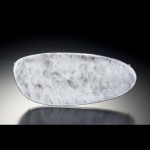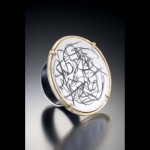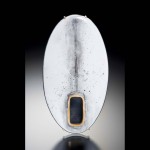This is the second in an ongoing series of interviews with artists who are making a living through their art and complimentary careers (or ‘day jobs’) that encourage their creativity and artistic expression. If you are an artist and are interested in being interviewed as part of this project, please visit our contact page.

Today’s interview is with Christy Klug, an up and coming jewelry artist who had her first major sale by super-gluing her pieces together for her show because she hadn’t yet figured out how to attach the metal pieces together! She’s come a long way since then!
What kind of artwork do you do?
Metal jewelry. I’d like people to know about all the sketching, pattern making and editing that happens before a new piece of jewelry is actualized. Each piece can take 4 to 5 days to create and with my enamel work each piece is truly a one-of-a-kind.
I understand you are self taught? Tell us how that process went, and how long it took between the time you started & the time you sold your first piece.
I could visualize the aesthetic I wanted to achieve in my jewelry, so I was truly driven to learn all that I needed to know to bring my idea’s to fruition. I took an introduction to fabricating jewelry class in Austin. I learned some basic skills like piercing; cutting into the metal with a jewelers saw. I started sawing my drawings into silver and hacked through some cold connection techniques on my own.
I sold some pieces at studio sales I hosted with other local artists. I did some research on shows and where galleries connected  with artists and found out about the American Craft Council show in Baltimore, the top wholesale show in the country. I had a friend photograph 5 pieces and applied to the show … and much to my surprise, I got in! I had 3 months to create a line, design a booth, devise a pricing strategy and go exhibit my new work. I didn’t know how to solder at that point, so I crazy glued all the backs on my earrings. They all came off on the plane ride. I hid in my booth amongst the top jewelers in the country and glued them back on.
with artists and found out about the American Craft Council show in Baltimore, the top wholesale show in the country. I had a friend photograph 5 pieces and applied to the show … and much to my surprise, I got in! I had 3 months to create a line, design a booth, devise a pricing strategy and go exhibit my new work. I didn’t know how to solder at that point, so I crazy glued all the backs on my earrings. They all came off on the plane ride. I hid in my booth amongst the top jewelers in the country and glued them back on.
I wrote $8000 in orders from galleries around the country at that first show and came home with the realization that my metalsmithing skills needed to come up a notch before I could ship the orders. Getting up to speed technically while on a production deadline was challenging, but pushed me to learn quickly. I have spent the last 5 years taking classes from a local art jeweler, teaching myself specific applications of enameling and working away in my garage, which is now my studio.
My work has evolved along with my technique. Today I am most proud of my enamel work which I taught myself from start to finish and which is a new direction that is getting me noticed with top shows and clients across the US. But everything I have learned along the way has allowed me to be where I am right now so the journey is the learning!
 Who was your inspiration when you got started?
Who was your inspiration when you got started?
I have always been inspired by the artists whose lines and gestures I find compelling and powerful and whose art informs my work; Gerhard Richter, Jean Arp, Johannes Schreiter, Cy Twombly, Brice Marden, Hans Hartung, Sol LeWitt, Ludwig Schaffrath. I have also always admired Millicent Rogers, (oil heiress and style icon) who collected traditional Indian jewelry in Taos New Mexico in the 40’s and 50’s and designed her own sculptural silver jewelry. She wore jewelry with an amazing sense of style and drama and made me aware of the power jewelry has when worn as a very personal statement.
Do you have a ‘day job’ or do you make a living selling jewelry?
I do not have a day job; making jewelry and raising my boys takes up most of my time.
How’s business?
Business has been good. I have managed to survive while learning about the business and technical aspects of doing this for a living. I’m dedicated to my craft and my vision. Therefore I keep my personal expenses low and I live very simply. Each year gets better and I’m no longer making some of the big investment mistakes like attending bad shows or the wrong shows for my work. I made this mistake in the first few years, which costs time and money.
What does the term ‘selling out’ mean to you? Have you had to deal with people calling you a sellout?
Realistically, a balance is necessary between some kind of production work and the yummy over the top pieces. I was very caught up in not being perceived as a sellout when I started making a living with my work. I’ve now exhibited next to some of the top metalsmiths in the country and they all have work in their booths that is their bread and butter.
What is one thing about your current career that you didn’t anticipate when you were younger? How did your career evolve in ways you didn’t expect?
I kind of jumped head long into this field. I don’t know that I anticipated or expected anything. I’m amazed that I’ve learned as much as I have and that my work has evolved the way it has. I have become more confident in my approach to my work and more secure in my skills in building each piece. As with all things we become passionately involved in, there is so much more to learn then we are initially aware of. I am more determined than ever to keep pushing myself to create better and better work.
If you could give other artists advice about money or getting started in their career, what would you say?
I think a lot of people think they can’t begin until they have a dedicated studio space and all the tools that were available to them in school. It’s possible to start small and build slowly.
Yes, starting slowly and building is a great idea. Then you really get a feel for whether it is going to have staying power for you and if it’s your true passion.